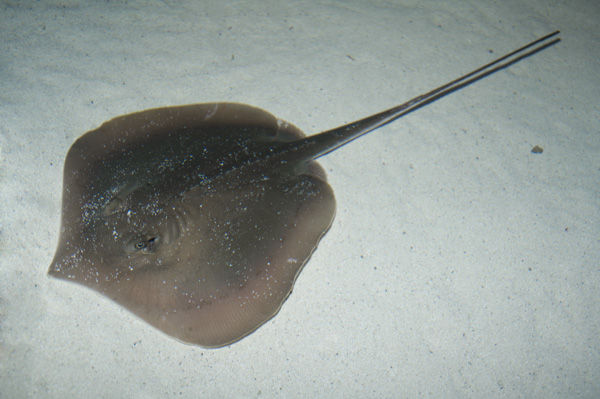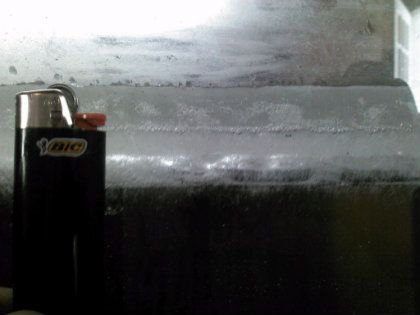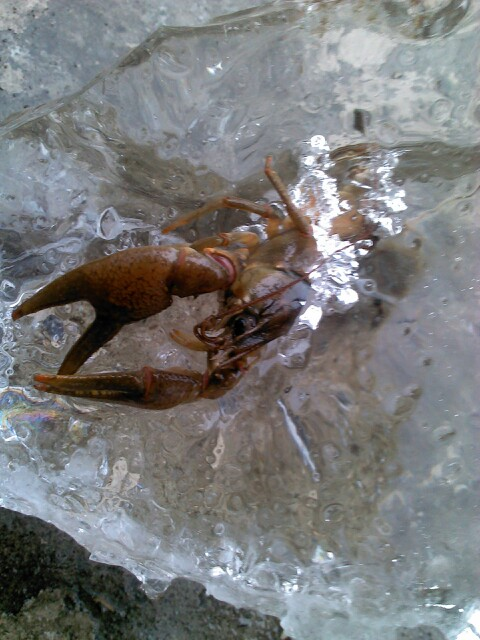Fishing With Face
Thread Rating:
| January 8th, 2013 at 3:02:39 PM permalink | |
| Face Member since: Oct 24, 2012 Threads: 61 Posts: 3941 |
Same. That thing in your pic is bonkers. I've fished salt a few times. In my younger days, I befriended an old Korean lady who taught me how to catch blue crabs. Spent hours trying to trick those little buggers in.  I was catching a fair share of grouper and grunts when I pulled one of these from the water. I didn't know what to do with it. Pops almost grabbed it when the Korean lady flipped on him. She ended up removing it for me =)  I tried catching some 2'-4' sharks when my line went taught. No pull, no wiggle, just taught. Thought I snagged something, but when I pulled really hard I felt it give. 5 minutes go by and I thought I caught a tire. 10 minutes go by and I though I hooked a dead body. It was like dragging an 8'x4' sheet of plywood through the water. After a half hour, I finally got it in and it was a stingray as big around as a 55gal drum.  All of these were from the shore, within a cast of people clam digging, friends body surfing, and kids playing in the surf. And you want me to swim in that? Nah, brah. I'm good right here ;) Be bold and risk defeat, or be cautious and encourage it. |
| January 18th, 2013 at 11:38:04 PM permalink | |
| Face Member since: Oct 24, 2012 Threads: 61 Posts: 3941 | Narrowly avoided disaster... Back in like September, my tank had evaporated to the point that the pumps no longer worked. I only have a chub and about 7 craws in over 100 gallons, and I was too lazy to fill it. It was getting cold, their metabolism was dropping, I figured they'd be fine. Fast forward to now, and I noticed it looking funny. Due to its size, anytime the temp moves more than the typical day/night cycle, it sweats. Just too much water to heat and cool quickly. It does it enough I kind of don't notice it, and I just barely noticed it this time. Whatever, just sweating again. Day goes by, still sweating. And another. And another. Like two weeks go by, and I decide to feed the buggers. I drop in the food, and tink-tink-tink, it goes bouncing all over. Water is frozen! I tap the surface, hard as a rock. Look at the sides, and it's not sweat, the entire inside surface of the glass is frozen top to bottom. Hard pokes, almost a punch, still can't break the surface ice. 20 gallon milk jugs of hot tap water later and I got the ice melted and pumps running again. My pets are fine, but if that had gone on much longer, I think the tank would've gave up. I can't imagine the damage that much water would've done to my garage and the contents therein. Someone get me out of this frozen hell!  Be bold and risk defeat, or be cautious and encourage it. |
| January 23rd, 2013 at 9:07:58 AM permalink | |
| Ayecarumba Member since: Oct 24, 2012 Threads: 89 Posts: 1744 | That's funny! Pouring warm water in a frozen tank risks shattering glass. Of course, frozen water in the tank will crack it too. I recall that adding warm water "tricks" some fish into thinking Spring has arrived, and they will start their spawning cycle. I wonder about ice fishing. There is obviously enough oxygen to support fish and whatever they eat under the ice, but where does it come from? Are the lake surfaces only partly frozen? Does enough oxygen seep through the ice? |
| January 23rd, 2013 at 1:17:59 PM permalink | |
| Face Member since: Oct 24, 2012 Threads: 61 Posts: 3941 |
Yeah, well, you've read me for awhile. You should know by now I don't always pick the smart path when making decisions ;) I actually do that for my windows as well. Don't even own an ice scraper, I just dump a 2ltr of hot water onto it. Windshield's chipped, too; haven't had a problem yet. I did notice them perk up after doing so, but I'm not sure there was hot enough water to warm it enough or for long enough to mess with their biology. All that energy to melt the ice, not to mention the 100+gal in the tank, and I doubt it got over 40*F. And if you thought that was funny, you'll think this is hilarious...  That a standard Bic lighter. The high around here's been about 10*F this week, and I got a solid 1.5" of ice on every side. Yeah, that's not just surface ice. I wish my camera could pick up the detail of the sides and bottom. If I shattered the tank with a hammer, I don't think I'd lose a drop of water. It's basically a 100+gal tank made of ice that just happens to be surrounded by glass =/  This is a 75gal pump, and you can see the other in the background. It nearly froze solid 2 days ago, whining like mad but barely putting any water out. It's flowing just enough to keep a 4" circle of open water to drain into. I'm getting nervous, but I can't thaw that much ice. That blurry bit on the left edge is the flowing water, all the rest that you can see in detail is frozen solid.
Aquatic ecosystems are amazing, the biology involved incredible. There's so much that goes into something as simple as "oxygen". O2 gets into the water by diffusion, aeration, and oxygenation. Diffusion is the movement of substance from high concentration to low. If the water has less O2 than air, O2 will simply "seep in", the same way tea from a tea bag seeps into a glass of water. Aeration is when water gets "spread", such as in waves or falling over rapids. When water gets spread, there's more surface area in contact with air, which allows for more diffusion. Rapids will have a higher O2 concentration than a stagnant pond, for example. Oxygenation comes from aquatic plants, which give off O2 same as trees, but directly into the water. Plants are give and take. While they pump out the O2 while alive, their death causes an influx of aerobic bacteria, which use O2 to break them down. This isn't a big deal for always-thawed Florida, but here in NY, a smaller, isolated body can die, often called "winter-kill". The water surface is frozen so there's no diffusion, there's no tributary (or they're also frozen) so there's no aeration, and all the rotting plants suck the O2 out of the water, killing all the fish. Fortunately, any naturally occuring body of water has a tributary, often a great many of them. Brooks and streams dump into rivers and creeks which thrash and gurgle their way across the land, picking up O2 all along the way. When they finally dump into a lake, they're chock full of O2 and the process never stops. While the bacteria are another sink in the O2 table, every single other thing has dropped to bare minimum metabolism. This constant influx of O2 rich water is usually more than enough to keep a body alive. For the fisherman who haven't yet been scared off yet, this information can help break through a fishing slump. In the summer, large bodies of water go through "thermal stratification". If you've ever had a pool, you know what this is - top 2 inches is 70*F, you jump in, bottom 4 feet is 55*F lol. Large bodies do the same thing. The sun heats the top layer but can't reach the bottom, causing a seperation of layers not unlike ice vs water. These two layers differ so much that they don't mix, again, like ice and water. Many newer fish finders are sensitive enough that you can see the "strat line", the exact border between the zones. In mid summer, a guy knows that high temps lower the O2 count and make fish uncomfortable, so the guy goes deep. But he doesn't know that the deep water, while cold, isn't getting mixed with the aerated upper layer, and is further being depleted of O2 by all the stuff rotting on the bottom. It is, in effect, a "dead zone". For the rest of the summer, the guy catches nothing. This is why I love fishing. Sure, you can tie a line and just throw it, might even have a great day of it. But it's getting into the biology, the chemistry, the science of it all, figuring out the puzzle and pulling fish when no one else can, that's what keeps me going day after day, week after week, for some 30 odd years. It's science, and you can do it with a beer in your hand =) Be bold and risk defeat, or be cautious and encourage it. |
| January 23rd, 2013 at 2:25:50 PM permalink | |
| Ayecarumba Member since: Oct 24, 2012 Threads: 89 Posts: 1744 | That was awesome Face. Thanks! Could you put one of those cheap goldfish bowl heaters (the ones that look like a test tube) into the reservoir of your filter to warm the water before it drops back into the tank? This might be enough to gently raise the temperature of the water as it circulates. Of course it would trash the bacteria in your filter, but I don't think it matters when the icebox has them in stasis. |
| January 23rd, 2013 at 3:37:00 PM permalink | |
| Face Member since: Oct 24, 2012 Threads: 61 Posts: 3941 |
Thanks, and you're welcome =) I thought of the heater, I have one in my inside tank that I'm not really using. But that little thing is for keeping the 10gal tank at 74*F when the house is 68*F. My outside tank is 100+gal, 32*F, and is sitting in a garage that's been averaging about 0*F. I kind of feel that using it will be like digging to China with a stirring straw. My tank's about 4' x 2' x 1.5', and every side has 1.5" of ice on it. That's going to take some serious thawing and I don't want to chance a partial thaw. I got a 65,000 BTU torpedo heater for the garage, but at a 70*F ambient temp that would still take weeks. I got heating bulbs you could fry an egg on, but again... I think the only thing I could do that would work is drain half of it and refill it with warm water, which, if it doesn't shock-kill everything in it, would take the better part of a day and just refreeze again in a week. Seems my only option is what I usually do - leave it to chance and hope for the best =D 2 weeks down, 7-9 more to go. Place your bets! Be bold and risk defeat, or be cautious and encourage it. |
| January 30th, 2013 at 7:27:26 PM permalink | |
| Face Member since: Oct 24, 2012 Threads: 61 Posts: 3941 | So JB, you think the crayfish's regenerating claws are amazing? The last two week panic I went through due to my freezing tank finally let up. The ice was passing the 5" mark when WNY's famous weather went from a week of single digits to 4 straight days of 50's. The ice stopped forming and then starting melting, but tomorrow's dip back into sub-freezing temps brought another problem - the ice wasn't going to completely melt. I had basically a box within a box, which were seperated by an inch of water. That water was going to freeze, and one of the two boxes were going to give up. Not leaving it to chance, I took action. I drained half the tank to get the air in there to work on it. It worked well, but not fast enough. I ended up going out there with some hot water and a screwdriver, eventually breaking the ice box in half so I could just remove it and refill the tank. It worked well, but taking out a 2' x 2' x 2' block of ice wasn't easy, and I dropped it the first time I tried lifting it. I was worried I just squished something, so I got some gloves on and tried again, focusing on the bottom of the ice. As I lifted it the second time, I notice what looked like a crayfish coming with it. I was worried I had impaled it when I dropped the block, but didn't notice any visible damage. It wasn't until I got it near the surface that I froze (pun!) in shock and dismay as I realized that one of my larger craws had somehow become nearly encased and frozen within the ice box!   I was somewhat saddened and tried figuring out how it died. It wasn't in an area it could've gotten trapped, pinned, and allowing it to freeze, and it wasn't on the bottom, so it died sometime recently. It had no visible damage, had no visible infection, so I started moving its claws out of the way to get a look at it and have a feel of it. Wouldn't you know, the claws ever so slowly reared up into the defensive position! The thing was still alive! I got the screwdriver back out and chiseled his chunk of corner out, put it in a pot, and filled it with cold (~45*) water. Over the next 20 minutes or so, it slowly got more and more active as it warmed, and once the ice melted enough, he crawled out of his tomb just as normal as could be. He looked a little stiff, falling over rocks and having difficulty righting himself, but an hour later he was crawling around just as nimble as could be. I ain't never seen nothing like it. Freezing, 100% of the time whether animal or plant, explodes the cells and terminates the life, leaving what's left all mushy and without substance. This thing though just seemed to take a nap for a bit until he wasn't frozen anymore. Amazing stuff =) Be bold and risk defeat, or be cautious and encourage it. |
| January 31st, 2013 at 2:16:54 AM permalink | |
| JB Administrator Member since: Oct 23, 2012 Threads: 10 Posts: 111 |
“The Case of the Cryogenic Crayfish” — very nice! I was wondering if that was how the story would end. Am I mistaken, or does this particular guy have a regenerated left claw? It might just be the camera angle and/or the fact that it froze while shut. How ironic that a couple of weeks ago you wrote:
|
| January 31st, 2013 at 10:41:54 AM permalink | |
| Ayecarumba Member since: Oct 24, 2012 Threads: 89 Posts: 1744 | Amazing! It appears that his gills weren't frozen over, so that may be how he was able to survive. Kudos to you for not pouring hot water on him during the rescue. |
| January 31st, 2013 at 1:51:27 PM permalink | |
| Face Member since: Oct 24, 2012 Threads: 61 Posts: 3941 |
Nope, he's intact. That claw just happened to be turned. All of my guys are 100%. They're the ones that found a home and didn't get eaten by the bass over the summer. 12-16 "homes" for 7-8 craws and it's always dark-ish, so they mostly stay exposed all day. No conflict, no damage. Kind of sucks because now I'm pulling for them. Don't know how I'm ever gonna put a bass in there again and risk them getting eaten lol
They weren't, and I wonder how much that had to do with anything. The gill/mouth area is the first place I look when determining death, as sometimes they lay at weird angles and almost "check out", not moving even when stimulated. This one was completely static for the whole 2 minutes I was going over it, gills/mouth included, and didn't move until I touched it. I don't know if he sat on the ice too long, froze in, and then got encased, or whether they shut down into stasis like amphibians and "wake up" when they thaw, but it was cool either way. I'll have to do some research, I think. 10-4 on the hot water. Even the hose water that I filled it with versus the 32* water in the tank had me concerned, as it doesn't take much. These things are more hardy than your typical pet store tropical fish, but I've noticed the effect over the years I've done this. I've never had one shock to death, but the 10* difference between tank and crick or lake and tank usually makes them act funny, almost "seize up". But cold tap water was all I had, and I took a chance that a little bit of shock was better than 8 more weeks of frozen tomb =) Be bold and risk defeat, or be cautious and encourage it. |

